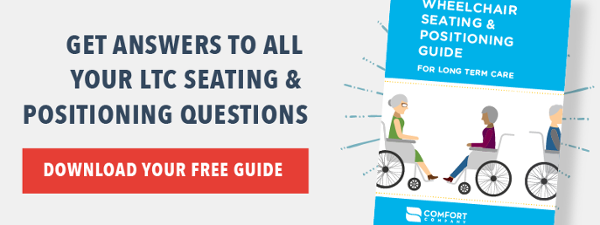Part 12 in our LTC Seating & Positioning series intended to shed some light on the mystery of seating and positioning in the LTC setting. See the rest of the blog posts in the following links: Part 1 (Best Wheelchair Options in LTC), Part 2 (Posture Problems), Part 3 (Posterior Pelvic Tilt), Part 4 (Anterior Pelvic Tilt), Part 5 (Pelvic Obliquity), Part 6 (Pelvic Rotation), Part 7 (Fixed vs Flexible Postural Abnormalities), Part 8 (Windswept Posture), Part 9 (Incorrect Seating Dimensions), Part 10 (Issues with Current Wheelchair System: Seat-to-Floor-Height), Part 11 (Issues with Current Wheelchair System: Back Support)
Looking for more information on seating and positioning? Check out our digital, rehab-focused Wheelchair Seating & Positioning Guide here.
Leg rests are a critical piece of an optimal wheelchair system. Therapists often undervalue the important role leg rests play to ensure proper foot, lower extremity (LE), pelvic, trunk, and head alignment and stabilization. Leg rests:
- Stabilize the LEs, assisting in optimal alignment of the pelvis and spine
- Promote femoral contact for pressure redistribution away from bony prominences of the pelvis to reduce the risk of a pressure injury
- Assist in stabilization from the foot all the way to the head and neck to prevent unwanted movement, allowing for maximum alignment to promote independence and safety at wheelchair level.
There are many leg rest issues that can arise if leg rests are not fit or set properly or if the wrong style of leg rest has been chosen for the wheelchair system. Some common issues are:
- The use of only one leg rest
- Unequal foot plate heights
- Leg rest too short or the foot plate too high
- Leg rest too long/foot plate too low.
The Use Of Only One Leg Rest
Sometimes only one leg rest is necessary, but having only one can cause the issues listed in the chart below. When considering the addition of a second leg rest, decide what is more important: one-legged propulsion OR the prevention of a postural abnormality. Sometimes we just can't have our cake and eat it too.
|
USE OF ONLY ONE LEG REST
|
||
| What is going on? | Negative Result | What can you do? |
|
Pelvis on the side with the leg rest is higher |
Pelvic obliquity |
Add second leg rest if positioning is your goal |
| One-legged heel strike for propulsion | Pelvic rotation |
Add second leg rest if positioning if your goal |
| LEs will "sweep" toward the slide with the leg rest | Windswept positioning of LEs |
Add second leg rest if positioning is your goal |
The charts below break down other specific issues your patient could be having in relation to improperly fitted leg rests.
| UNEQUAL FOOT PLATE HEIGHTS | ||
| What is going on? | Negative Result | What can you do? |
| Unequal foot plate heights cause one side of the pelvis to be higher | Pelvic obliquity | Adjust foot plate heights to be even |
|
LEG REST TOO SHORT/FOOT PLATE TOO HIGH
|
||
| What is going on? | Negative Result | What can you do? |
| Decreased femoral contact, which increases peak pressure at the ITs, sacrum, and coccyx | Wound risk at ITs, sacrum, and coccyx |
Measure lower leg length Lengthen leg rest/lower foot plate Look for a skin protection cushion that immerses and/or offloads the bony prominences |
| Decreased femoral contact cause LEs to "sweep" to one side | Windswept positioning of LEs |
Measure Lower leg length Lengthen leg rest/lower foot plate Find a cushion with medial abduction and lateral adduction contours to maintain LE alignment |
| Decreased femoral contact increases hip flexion pulling downward on the pelvis |
Posterior pelvic tilt aka sacral sitting Shortened hamstrings |
Measure lower leg length Lengthen leg rest/lower foot plate |
| LEG REST TOO SHORT/FOOT PLATE TOO HIGH | ||
| What is going on? | Negative Result | What can you do? |
| Resident slides forward and stretches legs to reach foot plates | Posterior pelvic tilt aka sacral sitting |
Measure lower leg length Shorten leg rest/raise foot plate |
| Promotes sacral sitting that adds pressure directly onton the ITs, sacrum, and coccyx | Wound risk at ITs, sacrum, and coccyx |
Measure lower leg length Shorten leg rest/raise foot plate Look for a skin protection cushion that immerses and/or offloads that bony prominences |
| Resident stretches foot & ankle downward to reach a foot plate that is too low promotes ankle plantar flexion & inversion | Contracture risk of ankle joint |
Measure lower leg length Shorten leg rest/raise foot plate Use of a single or double foot support |
| Resident stretches to reach the foot plate, only the ball of the foot makes contact with the foot plate | Risk of eliciting abnormal reflexes and tone |
Measure lower leg length Shorten leg rest/raise foot plate Use of a single or double foot support |
Another common issue related to leg rests is the overuse of elevating leg rests on manual wheelchair systems. Please refer to past blogs that discuss how this issue can:
- Pull the pelvis into a posterior pelvic tilt
- Decrease circulation in an edematous LE
- Increase the risk of a pressure injury on the pelvis
- Decrease LE alignment and increase the risk of contracture management.
It is critical that we as therapists take the time to not only choose the appropriate cushion and back support but understand the value and importance the leg rest plays in providing the best seating system possible to our patients!
Please refer to the Seating and Positioning Guide to see what measurements need to be taken to ensure an accurately fitted wheelchair system!

Ana Endsjo, MOTR/L, CLT
Clinical Education Manager LTC Division
Ana Endsjo has worked as an occupational therapist since 2001 in a variety of treatment settings. She has mainly worked with the geriatric population, dedicated to the betterment of the treatment of the elderly in LTC centers. Her focus has been on seating and positioning and contracture management of the nursing home resident. With this experience, her hope is to guide other therapists, rehab directors, nurses, and administrators through educational guides, blogs, webinars, and live courses in her role as Clinical Education Manager for the long term care division.

